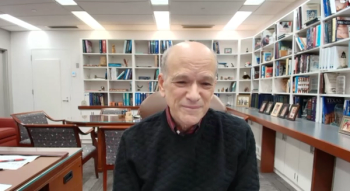
- Vol 40, Issue 2
Treatment Resistant: Is It a Misnomer?
"The history of medicine is rich in blaming the disease or the patient for 'untreatable' symptoms, until we stumble upon or develop a treatment that is, in fact, effective."
As novel treatments emerge for clinical treatment of various psychiatric disorders, the goal is a faster onset and greater degree of symptom improvement with good tolerability. However, below the surface is a question that I often ask myself: Why do we label treatment nonresponders as treatment resistant?
The truth of the matter is that we simply have not yet developed a comprehensive and detailed understanding of the variables that converge to create the disorder we are trying to treat. The history of medicine is rich in blaming the disease or the patient for “untreatable” symptoms, until we stumble upon or develop a treatment that is, in fact, effective.
Much of drug development in psychiatry evolved serendipitously or through a process of distilling an active ingredient out of a naturally occurring substance. Serendipity led to the development of chlorpromazine to treat psychosis and monoamine oxidase inhibitors to treat depression. In both cases, an unfortunate consequence of these discoveries was ultimately a stagnation in development of treatments with entirely different mechanisms of action (MOAs).
As the cover stories in this year’s
Both disorders have expansive heterogeneities of etiologies that can differ remarkably from one person to another. At least one-third of patients with schizophrenia do not improve with our current armamentarium of dopamine-2 receptor-blocking drugs,1 and one-third of patients with a unipolar major depressive episode do not improve despite numerous treatments based on all iterations of modulating neuronal serotonin, norepinephrine, and/or dopamine.2,3 In fact, it is remarkable that the number of nonresponders is not higher.
My vote is to eliminate the term treatment resistant and change it to something such as nonresponsive to currently available treatments. As novel treatments emerge, after 2 trials on a drug class of 1 MOA, it would be prudent to switch to an entirely different MOA. If some improvement has occurred, augmenting with a different MOA agent may provide further symptom improvement.
We are already doing this with some patients by adding intranasal esketamine (glutamate MOA) to a traditional antidepressant (monoamine MOA) or adding an atypical antipsychotic to lithium in bipolar disorder. Ideally, having a menu of numerous classes of drugs with different MOAs would allow us to find the MOA that helps a particular patient the most, or to combine drugs to maximize benefit by modulating different mechanisms that synergize symptom improvement.
Given the complexities of the brain, it is likely that we will be adding novel MOA drugs for decades to come. Hence there is optimism in psychiatry that our armamentarium of treatments will continue to expand, with an accompanying increased ability to manage, improve, or possibly totally remit psychiatric symptoms in some cases. An analogy from primary care is the current approach to treating hypertension—a much simpler disorder than depression and psychosis.
The current approach is to start with 1 of 5 drug classes: diuretics, β-blockers, calcium channel blockers, angiotensin II receptor blockers, or angiotensin-converting enzyme inhibitors. Some patients may have an excellent response to 1 of these drug classes, but a more modest or no response to another. If there is no improvement on the first treatment, the patient’s hypertension is not deemed treatment resistant, but rather nonresponsive to that class of drugs. It is not uncommon for some patients to be on 2 or 3 different classes of drugs simultaneously to optimally manage their hypertension.
Our challenge in psychiatry is to dismiss our tendency to project frustration over our inability to cure psychiatric disorders or to achieve larger degrees of improvement in our patients’ symptoms. Instead, we need to ensure that we are using all the available tools to maximize clinical improvement while accepting the fact that psychiatry is a young specialty and we still have a great deal to learn.
To call out one of the elephants in the treatment room, having significantly more time to spend with our patients would allow us to provide more comprehensive evaluations, establish the full range of target symptoms and behaviors contributing to their distress, and more thoroughly discuss the many lifestyle changes and treatment options that could improve their symptoms and functioning. This could lead to improved outcomes while the wheels of science and innovation continue to grind forward to enhance our treatment paradigms.
This may sound fanciful, but if we reflect on the history of medicine over the past century, this defines the path we have been traveling on. What concerns me most is the steady decrease in time we are spending with our patients as administrators and insurance companies puppeteer our schedules and treatment choices.
John J. Miller, MD, is Editor in Chief Dr Miller is Medical Director, Brain Health, Exeter, New Hampshire; Editor in Chief, Psychiatric Times™; Staff Psychiatrist, Seacoast Mental Health Center, Exeter; Consulting Psychiatrist, Exeter Hospital, Exeter; Consulting Psychiatrist, Insight Meditation Society, Barre, Massachusetts.
References
1. Potkin SG, Kane JM, Correll CU, et al.
2. Sinyor M, Schaffer A, Levitt A.
3. Zhdanava M, Pilon D, Ghelerter I, et al.
Articles in this issue
almost 3 years ago
Eating Disorders Among Older Adultsalmost 3 years ago
Addressing Unmet Needs and Clinical Challenges in MDDalmost 3 years ago
The Psychiatrist’s Role in Caring for Adolescents With Eating Disordersalmost 3 years ago
Bulimia Nervosa: Diagnostic Clarification and Determining Levels of Carealmost 3 years ago
The Status of Neuromodulation Trials in Eating Disordersalmost 3 years ago
The Fight for Psychiatric Rights and Accountabilityalmost 3 years ago
Lawmakers Support CMS Rules to Streamline Prior Authorizationsalmost 3 years ago
"What a Psychiatrist Remembers"almost 3 years ago
Research Explores the Efficacy of Clozapine as a Treatment for Catatoniaalmost 3 years ago
Treating Acquired Brain Injury With Noninvasive Brain StimulationNewsletter
Receive trusted psychiatric news, expert analysis, and clinical insights — subscribe today to support your practice and your patients.

















